The Printing Press: The Ancestor of the Internet and Foundation of Modern Life
The Printing Press: The Ancestor of the Internet and Foundation of Modern Life
Over the course of human history, few innovations have dramatically changed the course of cultural development in all aspects. The printing press is one such innovation that was so monumental that it helped bring about an entirely new era of civilization. The invention not only progressed the printing technology of the time, but swiftly expanded the spread of knowledge and ideas all across the European continent and later the rest of the Earth. The spread of knowledge caused a shift from the suppression of thought and submission to faith in the Middle Ages to the age of reason and scientific thought in the Enlightenment Era. The increased spread of ideas meant that due to the printing press, more innovations would be made in a shorter period of time. Rapid technological developments improved human life, with the innovations of life we have today stemming from the influences of the printing press.
Historical Background
The design of the printing press did not differentiate much from that of previous printing technologies. The concept of printing had been around for over a millennium before the creation of the printing press, beginning in China circa 200 AD (American Printing History Association). Printing was done using carved wooden blocks that would be dipped in ink and then pressed on paper or cloth by hand. The subsequent iteration of the technology came with the movable type, which also used wood or clay for the printing tool. Developed around 1000 AD also in China, the movable type included an organized system to representing language in printed text. Entire words were carved into the blocks that would then be transferred to paper. The ancient Chinese script of thousands of characters prevented movable type from being an efficient form for writing.
As the Europeans developed the movable type technology, the system became a viable option for printing. However, as the wooden or clay blocks were used, they would degrade quickly. Imperfections with the initial molding or after a few uses rendered the tools useless (IdeaFinder). Furthermore, with every piece of literature came the need for new blocks for previously unused words. The process of creating the blocks for new words proved to be wasteful as some would only be needed a couple of times. As a result, the creation of a single book or written document was a long and tedious process that needed revolutionizing.
Despite the lack of any major changes, the printing press’ solutions to troubles with the movable type technology made the printing press a major innovative creation. These anticipated changes are attributed to a German goldsmith by the name of Johannes Gutenberg who was able to create the first printing press in 1440.

Gutenberg’s printing press added to the movable type design that had been used for hundreds of years by creating a metal mold. The metal molds helped create metal blocks that were consistently durable with fewer imperfections compared to the previously used wooden or clay blocks. Furthermore, the metal blocks were made for individual letters and punctuation marks instead of just for entire words, meaning that the reusability of each block was much greater than by previous methods. Gutenberg’s organization of the blocks in a matrix also meant that the final product on paper was much cleaner and lined up well.
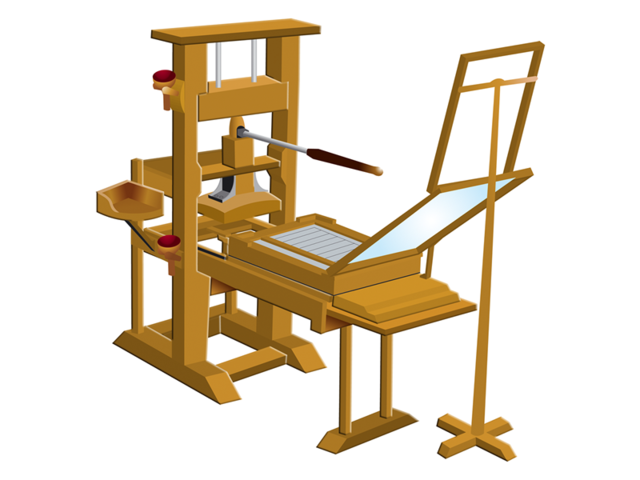
Gutenberg's first notable and most famous publication was the Gutenberg Bible, which he completed several copies of by 1455 (HistoryGuide). The copies were produced in only three years, a much shorter time than what would have been required with previous technologies. The printing press’ speedy production also meant that the publications could be sold at a cheaper price that’s more desirable to the customer.
The Impacts
The Impact on Writing
The first, most broad impact that Gutenberg’s invention made involved how it affected the way writing was practiced and traded. According to Natascha Gentz, professor at The University of Edinburgh, in her book, Globalization, Cultural Identities, and Media Representations, the printing press, “had not created anything entirely new, but increased a potential inherent in writing itself” (Gentz, p. 12). The modifications by Gutenberg sparked an increase in sharing of ideas.
No longer was a text or topic of thought bound to a single group. What used to be "circulated among close circles of friends and confidants” was now accessible beyond individuals with connections, leading to a separation of “writer, text, and reader” like nothing before (Gentz, p. 12). Sharing one’s work became even more of an importance when writing, as the audience for texts widened to all socioeconomic groups. The effect the printing press had on writing thus influenced the development of all other aspects of society.
The Impact on Society
The printing press paved the way for the mass production of texts that would in turn spread ideas across Europe. Though Gutenberg died in 1468, his legacy remained preserved through the success that the printing press started to gain by the end of the century. In 1499, an estimated 2500 cities in Europe had established print-houses (IdeaFinder).
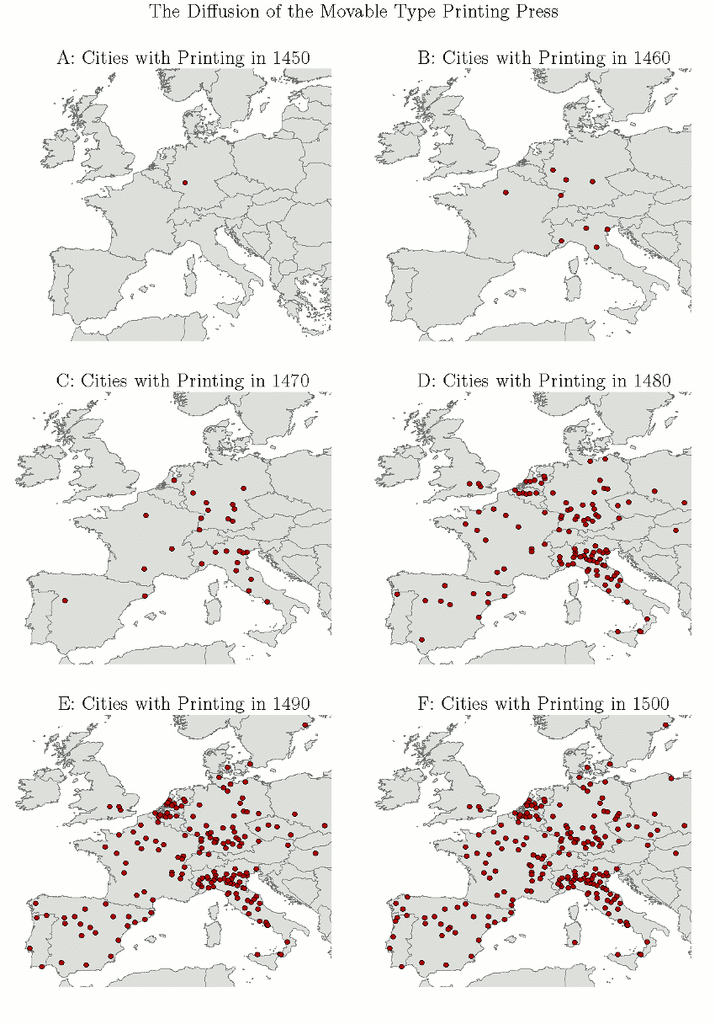
In these cities, with the help of the printing press, texts became much cheaper and easier to publish with the printing press. Millions of books with an estimated 30 thousand different texts were created and spread to individuals of all social and economic standing. Libraries became full of books for the public to indulge in.
According to Elizabeth L. Eisenstein, American historian and specialist in the history of printing, in her book The Printing Press as an Agent of Change, Volume I, printing shops became centers for individuals of different fields of knowledge to interact and further share ideas. Scientists became accustomed to learning from topics outside their specialization, some becoming “a new kind of protean, Renaissance man” (Eisenstein, p. 521). Furthermore, the greater availability of information and “output of practical handbooks” spurred the growth of the middle class and higher education across the public spectrum (Eisenstein, p. 386). The growth of these cities and the spread of the printing press went hand in hand.
In The Right Place at the Right Time
The doors to an era of greater information were beginning to open. The success of the Gutenberg printing press can be attributed to the fact that it was discovered in the right place at the right time. The use of the technology during this time in Europe gave importance to the technology itself.
In Europe, the relatively simple vernacular meant that the printing press could easily be integrated. The modifications that Gutenberg made along with the circumstances of the time enabled the creation to have monumental impacts on human interactions and culture. The evolution in communication of writing that was taking place enabled new ideas to spread quickly, especially those of individuals hoping to ignite changes to traditional thought.
A Transition of Thought
Religious reformation was one of these major changes in thought of the 16th century, involving a diversion from the very powerful Catholic Church of the Holy Roman Empire. Instilling dominance in the empire at the same level as the ruling government, the Church enforced strict control over press related to religious thought, making sure to crack down on blasphemous content.
Martin Luther, a German theologist, led the primary opposition against the Church, later known as the Protestant Reformation. His first publication in 1517 named the Ninety-five Theses outlined actions by the Catholic Church that he deemed illogical and against the teachings of the Bible, such as paid indulgences (Biography). The pamphlet's relatively small size compared to an entire book meant that the printing presses across the empire could produce thousands of copies quickly. The use of the technology was evident and crucial to the spread of Luther's preaching, thus the technology itself was able to flourish. Luther continued to produce other handout-sized texts that easily reached the public in the vernacular. He recognized the importance in connecting with his audience through translation of his texts to the local languages. Luther also understood that he was capable of doing so with the utilization of the printing press.
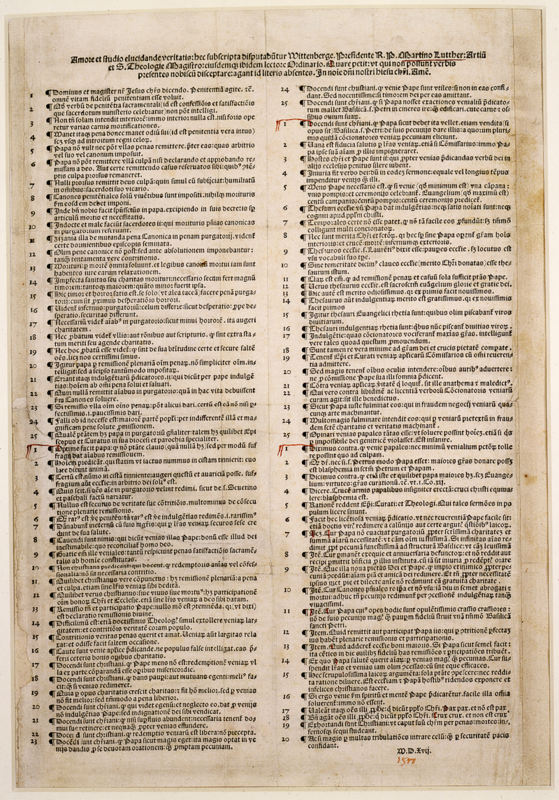
As described in the Economist piece “How Luther Went Viral”, the media produced via the printing press was likened to a disease by the Church. This media circulated despite the containment of the source, as Luther was excommunicated in 1520 and then further condemned in the Edict of Worms in 1521. As documented in the book Readings in European History, Volume II by James Harvey Robinson, professor of History in Columbia University in 1906, the Edict directly stated that Luther’s heresy had to be prevented, or else, “the whole German nation, and later all other nations, will be infected by this same disorder” (Robinson). Despite his exile, Luther’s teachings had, “taken hold in Germany and beyond. To use the modern idiom, Luther’s message had gone viral” (Economist). The religious thinking that was unchallenged for centuries was beginning its transformation.
The printing press brought about the great decrease of power in the Catholic Church. Even though the Church did not fail, the uncontrollable effect of the printing press in opposition to the Church disrupted the longstanding process of thought to bring about a new era of thinking.
A New Era of Scientific Thinking
The undergoing decrease of control of the public’s ideas about religion enabled greater freedom in scientific thinking and questioning, igniting the expansion of scientific research and theory. The opening in religion “[stimulated] the great advances in anatomy, physics and astronomy which are known as the scientific revolution” (Eisenstein, p. 648).
The Scientific Revolution, an era of collaboration of scientists and intertwining of ideas, was sparked by the printing press. The printing press innovated the way people communicated, changing the way science across Europe and later the world was practiced by encouraging the sharing of knowledge. With the ability to publish their works, various scientists were able to share research and pass down scientific understanding to future generations. This period of human history stands today as a period of truth of understanding the universe, as the discoveries during that time are perceived as laws of nature.
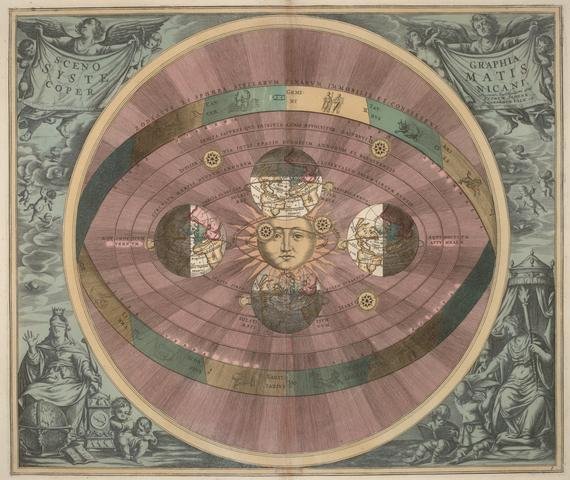
Kepler’s planetary investigations, Galileo’s mechanics, and Newton’s Principa all published their works, with each following scientist using the work of their predecessors (Eisenstein, pp. 660-662) . Kepler’s laws of planetary motion was used by Galileo in the creation of his modern telescope, which was then used by Newton for his publications on the laws of universal physics (University of Oregon). Today, we can attribute our understanding of science to scientists like these during a period of history right after the conception of the printing press.
The Digital Age
The ability to share ideas today has exponentially grown since the birth of the printing press. The innovation still makes an impact 500 years later, influencing the Digital Age, the age of knowledge transferred across the globe instantly with the use of the Internet, despite the transition to a paperless world. From social media to digital books to scientific research, ideas of all kinds are shared with anyone curious to learn.
As described by American essayist Sven Birkerts in his book The Gutenberg Elegies, reading and writing has indeed changed, as the “electronic media, while conspicuous in gadgetry, are very nearly invisible in their functioning” (Birkerts). The writer or creator of a piece has lost significance, with the information itself gaining in significance. Nevertheless, the practice of sharing ideas on a massive scale remains.

It seems evident that the faster and wider the communication achieved by an innovation, the greater the impact on human society. Just as the printing press brought about faster communication through a means of published books and written pieces, the Internet enables instant sharing like never before. Major innovations in communication and sharing of knowledge enable more subsequent discoveries to propel human technology further. The printing press inspired this spread of knowledge and will continue to inspire our ability as humans to read, write, communicate.
Sources/Acknowledgements
Image Sources:
Image 1: Benjamin Franklin printing press illustration. Illustration completed in 1902 (left) and Cloud computing stock image (right)
Image 2: Woodblock printing from a workshop in Hangzhou, China. Image captured in 2012
Image 3: Johannes Gutenberg portrait. Illustrated after his death
Image 4: Gutenberg Printing Press
Image 5: Printing Press European City Map
Image 6: Ninety-five Theses pamphlet published in Nuremberg. Published in 1517.
Image 7: Andreas Cellarius illustration of Nicolaus Copernicus's heliocentric planetary model. Completed in 1708.
Image 8: Digital Communication stock image
Research sources:
Ament, Phil. "History of the Printing Press - Invention of the Printing Press." The Great Idea Finder. N.p., 01 Jan. 1970. Web. 09 May 2017. LINK
Birkerts, Sven. The Gutenberg Elegies: The Fate of Reading in an Electronic Age. New York: Faber and Faber, 2006. Print. LINK
Eisenstein, Elizabeth L. The Printing Press as an Agent of Change. Vol. 1-2. Cambridge: Cambridge UP, 1979. Print. LINK
Gentz, Natascha, and Stefan Kramer. Globalization, Cultural Identities, and Media Representations. Albany: State U of New York, 2006. Print. LINK
"History of Printing Timeline." American Printing History Association. N.p., n.d. Web. 09 May 2017. LINK
"How Luther Went Viral." The Economist. The Economist Newspaper, 17 Dec. 2011. Web. 09 May 2017. LINK
Kreis, Steven. "The Printing Press." The History Guide. N.p., 2000. Web. 09 May 2017. LINK
"Martin Luther." Biography.com. A&E Networks Television, 28 Apr. 2017. Web. 09 May 2017. LINK
Robinson, James Harvey. Readings in European History: A Collection of Extracts from the Sources, Chosen with the Purpose of Illustrating the Progress of Culture in Western Europe since the German Invasions. Boston, MA: Ginn, 1906. Print. LINK
"Towards a New World Model: From Galileo to Newton: Physics Emerges." The Electronic Universe. University of Oregon, n.d. Web. 09 May 2017. LINK
Extra Links:
2. Information, Technology, and Economic Change: The Impact of the Printing Press by Jeremiah Dittmar
Hope you guys liked this piece! It took quite a while to piece everything together, but I hope that there was something new that you learned! If you really enjoyed it, upvote, resteem, and follow for more content of this quality in the future! 😊
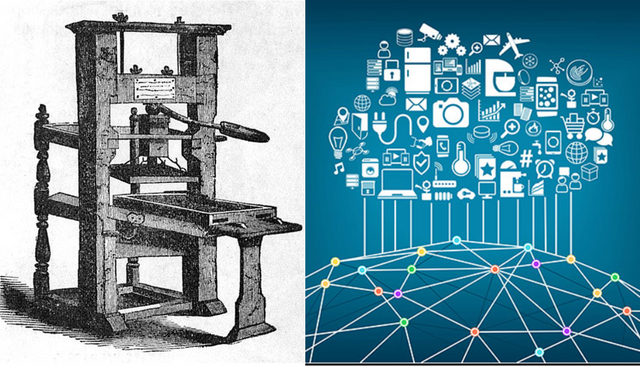
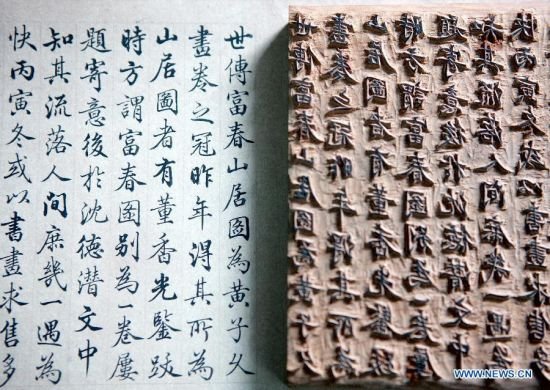
Congratulations @corediscovery! You have completed some achievement on Steemit and have been rewarded with new badge(s) :
Click on any badge to view your own Board of Honnor on SteemitBoard.
For more information about SteemitBoard, click here
If you no longer want to receive notifications, reply to this comment with the word
STOPBy upvoting this notification, you can help all Steemit users. Learn how here!
Congratulations @corediscovery! You have received a personal award!
Click on the badge to view your Board of Honor.
Do not miss the last post from @steemitboard!
Participate in the SteemitBoard World Cup Contest!
Collect World Cup badges and win free SBD
Support the Gold Sponsors of the contest: @good-karma and @lukestokes
Congratulations @corediscovery! You received a personal award!
You can view your badges on your Steem Board and compare to others on the Steem Ranking
Vote for @Steemitboard as a witness to get one more award and increased upvotes!